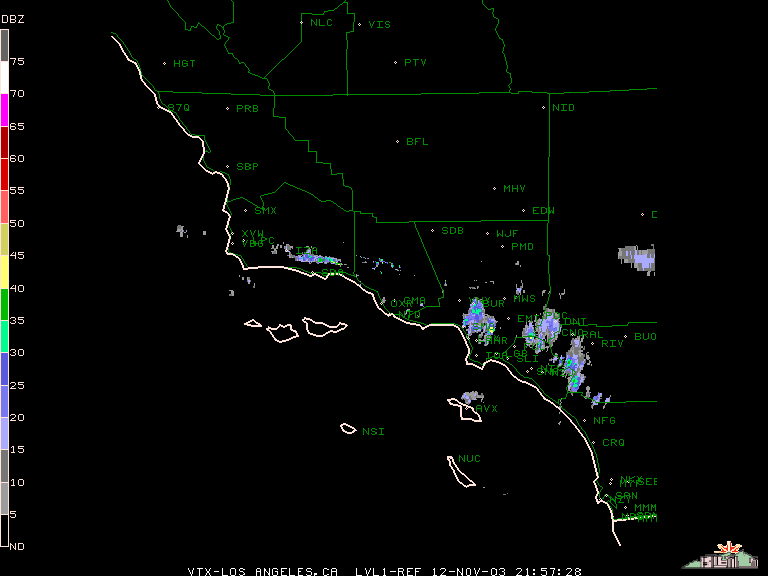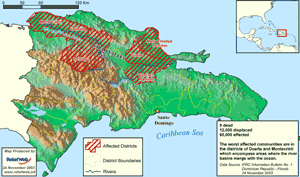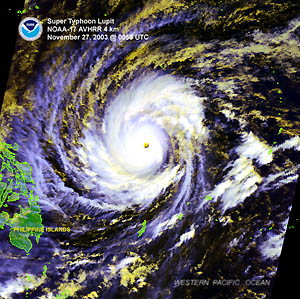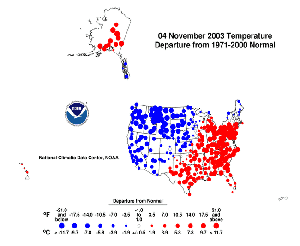


larger image
|
In Indonesia,
torrential rains caused flooding in a resort area near the capital
of North Sumatra region, Medan. The flooding caused a large
landslide, which affected the town of Bahorok on the 2nd. At least
151 people were killed, and the landslide was blamed partly on
illegal logging in the area and the subsequent deforestation (AFP,
Associated Press, BBC, OCHA). The flood destroyed dozens of
guesthouses, restaurants and homes along the banks of the Bahorok
River. |
Heavy rains struck the Muslim holy city of Mecca, Saudi Arabia,
on the 10th. Flooding was widespread in the city, with water levels
reportedly reaching as high as 6 meters (20 feet) in some areas.
The flooding claimed 12 lives and injured 50 people (AFP).
| Thunderstorms
developed in southern California on the afternoon/evening of the
12th and produced torrential
downpours across parts of the Los Angeles area. More than 125
mm (5 inches) of rain fell in just 2 hours in southern Los Angeles,
producing severe urban flooding. Small hail also accompanied the
storms, accumulating several inches deep in some areas of the city.
Nearly 115,000 electrical customers lost power as the storms
affected the area (Associated Press). |

Click
for Animation (Courtesy UCAR)
|
Flooding affected the central Appalachians and Eastern Seaboard
on the 19th, with some isolated 8-inch
(200mm) rainfall totals across mountainous areas. There were 11
deaths caused by flooding in the region (Associated Press).

larger image
|
Heavy rains
accentuated by the nearby passage of Typhoon Nepartak in the Gulf
of Tonkin produced flooding throughout the central provinces of
Vietnam during mid-November. Flooding and landslides claimed 61
lives in Vietnam and inundated over 32,000 houses (OCHA).
Significant flooding was also observed in parts of the country
last
month. |
| Heavy rains in the
Dominican Rebublic which began in mid-November produced significant
flooding across northeastern and northwestern areas of the country.
Flooding along the rivers Yaque del Nore and Yuna produced flooding
that damaged homes, crops, and inundated more than 200,000 hectares
(500,000 acres) of farmland. The floods displaced around 12,000
people and resulted in 9 deaths (IFRC). |

PDF
document
|
For an archive of flood events worldwide, see the
Dartmouth Flood Observatory.


| In the United States,
severe
thunderstorms produced a tornado near Darnestown, Maryland in
Montgomery county. Wind damage was also reported in parts of
northern Virginia and Maryland. |

larger
image
|
Severe
thunderstorms and several tornadoes accompanied a strong cold
front through the southeastern United States during November
18-19.



larger
image
|
Typhoon Melor developed in
the western Pacific Ocean on October 30th as a tropical depression,
reaching typhoon strength the next day. Melor struck the northern
Philippines on the 1st, passing over the northern province of
Isabela with maximum sustained winds near 140 km/hr (75 knots or 85
mph). The typhoon weakened to tropical storm strength as it passed
just east of Taiwan on November 2-3, bringing locally heavy rains
and gusty winds to the island. |
| Typhoon Nepartak
developed on the 12th in the Philippine Sea, and tracked through
the Gulf of Tonkin during the 17th-18th. |

larger
image
|

larger
image
|
Nepartak reached
maximum sustained winds of 140 km/hr (75 knots or 85 mph) as it
skirted the west coast of Hainan on the 18th. Torrential rains
produced flooding, especially through adjacent areas of Vietnam. In
the Philippines, Nepartak was responsible for 4 deaths and loss of
electricity to millions of people Disaster-Relief.org |
| Typhoon Lupit developed on
the 19th in the western Pacific Ocean and passed through the Chuuk
and Yap islands (Federated States of Micronesia) on the 23rd with
maximum sustained winds near 175 km/hr (95 knots or 110 mph). The
typhoon damaged or destroyed 200 homes and also damaged crops in
northeastern and southern outlying islands (OCHA). Lupit increased
in strength as it moved farther away over open ocean waters,
finally weakening as it recurved well east of Japan. |

larger
image
|


larger
image
|
A strong storm system
that moved across the U.S. Great Lakes and into Quebec during the
12th-13th produced a variety of weather impacts, including
severe thunderstorms, strong winds and heavy snowfall. Winds
gusting to 80-95 km/hr (50-60 mph) across the Ohio Valley, Great
Lakes, Northeast and Mid-Atlantic knocked out power to over 200,000
customers in the region (Associated Press). Heavy snows affected
areas of southeastern Canada, including Quebec, while snow also
fell downwind of the Great Lakes. |


| While the eastern
two-thirds of the United States was experiencing record-breaking
warmth during early November, cold temperatures enveloped much of
the northern Great Plains and Northern Rockies. Daily temperatures
were more than 10°C (18°F) below normal across much of
Montana and Wyoming. |

larger
image
|

larger
image
|
The first significant
snowfall of the 2003-2004 winter season arrived early in November
across parts of Montana, Wyoming and the Dakotas. |
In the U.S. Pacific Northwest, strong winds on the 19th cut
electricity service to around 67,000 homes and businesses in
Washington and Oregon. The storm brought a rare November snowfall
to the Seattle area, after 50mm (2 inches) of rain fell on the 18th
(Reuters).
| Snow cover increased
significantly across areas of Russia/Siberia during
October-November, encouraged by below
average temperatures across most of central Russia, Mongolia
and and Kazakhstan during November 2003. |

Click
for Animation
|
|
References:
Basist, A., N.C. Grody, T.C. Peterson and C.N. Williams, 1998:
Using the Special Sensor Microwave/Imager to Monitor Land Surface
Temperatures, Wetness, and Snow Cover. Journal of Applied
Meteorology, 37, 888-911.
Peterson, Thomas C. and Russell S. Vose, 1997: An overview of
the Global Historical Climatology Network temperature data base.
Bulletin of the American Meteorological Society,
78, 2837-2849.
|

 Flooding In The Dominican Rebublic
(pdf)
Flooding In The Dominican Rebublic
(pdf)














 NOAA's National Centers for Environmental Information
NOAA's National Centers for Environmental Information











